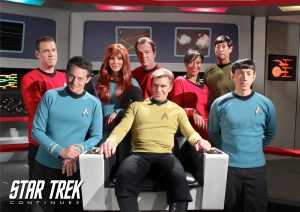 With just over half a day left until the close of their latest crowd-funding campaign, Star Trek Continues just crossed the half-way point to the goal of $350,000. And while getting half-way there might seem like they’ve fallen short, they now hold second place as highest-donation Indiegogo campaign of any Star Trek fan film!
With just over half a day left until the close of their latest crowd-funding campaign, Star Trek Continues just crossed the half-way point to the goal of $350,000. And while getting half-way there might seem like they’ve fallen short, they now hold second place as highest-donation Indiegogo campaign of any Star Trek fan film!
Remember that donations to Star Trek Continues, a registered non-profit, are now tax deductible in the United States. Also, any backer contributing $100 or more will get an exclusive EARLY VIEWING of their sixth episode “Come Not Between the Dragons” at noon Pacific Time on Friday, May 13…before it debuts to the rest of the galaxy.
More than $10,000 has come in between yesterday and today…can Star Trek Continues make it to the ever-elusive $200,000 before the campaign closes tonight?







 In what is likely the final documentation containing legal arguments to be submitted before the court hearing on May 9, 2016, the attorneys representing Axanar have just filed a Response to Paramount and CBS’s Response to Axanar‘s latest Motion to Dismiss (itself a response to Paramount and CBS’s Amended complaint for copyright infringement).
In what is likely the final documentation containing legal arguments to be submitted before the court hearing on May 9, 2016, the attorneys representing Axanar have just filed a Response to Paramount and CBS’s Response to Axanar‘s latest Motion to Dismiss (itself a response to Paramount and CBS’s Amended complaint for copyright infringement).